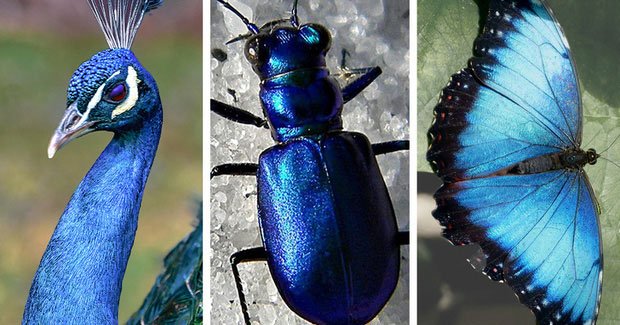There is only one animal in the world that is blue - why is this color so rare?
You know, blue is one of our favorite colors. The proof is that there are 75 countries with blue flags inside.
But in nature, it turns out this color is extremely rare, especially for animals. This color is so rare, the animals you meet this color can only be counted on the fingers.
And more importantly, even when encountering an animal in blue, it is unlikely that it will be their true color. But why is this color so rare?
The color of animals depends on what they eat

The colors of animals contain pigments in relation to the foods they eat each day.
Most colors on feathers, skin and feathers (of birds) contain pigments in relation to the food they eat every day. For example, goldfinches have yellow feathers because they often eat yellow flowers. Similar to flamingos, they feed on fish, shrimp, or shellfish in a reddish-pink color.
This rule also applies to other colors, like brown, red and orange. Particularly blue is a special case, because there is not any creature that actually contains blue pigment in people. Therefore, animals will not be green if based on the food they eat every day, and this is also why this is the rarest color in the natural world.
Green animals are not really "green"

Animals have developed a way of deceiving our sight.
You know, color is actually how we perceive light waves . And this rule really applies perfectly to the natural world.
Some animals we think are blue in color, but in most cases are the result of evolution. Animals have developed a way of deceiving our sight, by taking advantage of the feather structure and the ability to reflect light.
Blue butterflies, for example, are green because they possess a pair of wings that reflect light. The wings are structured to allow absorption of all colors, leaving only blue light. But because the green color is completely based on the microscopic structure, once the wings are influenced by other factors - such as alcohol, that color will disappear, even the shape of the wing will change. .
There are no birds that are truly green

Blue-colored birds do not have such a pigment in humans.
Many people may wonder why so many birds - like the Brazilian parrot or cassowary - crested ostrich - are also green on their bodies. But as stated, all are also in hair structure.
Blue-colored birds do not have such a pigment in humans. They take advantage of the fur structure to reflect only blue. Each hair will have tiny crystals, allowing it to absorb every color, leaving only blue. Like the parrot in the image above, if you look closely, it is actually green (green) rather than blue.
The only animal that is truly green

Only olive wing butterflies are green.
Blue is really rare, but not without. In the world exists only one butterfly of this color, with a name . unrelated: olive wing butterfly, or olivewing butterfly.
This butterfly evolved to possess some blue pigments at the wings, and this color cannot be changed regardless of whether you change the perspective or do anything with it (unless dyeing the wings is different). And why these butterflies have such a color is still a mystery to science.
- Animal world is blue
- Top 8 rare and threatened plant and animal species
- Finding a new green color and what it can do can surprise us
- Strange males know to lay in the animal world
- The world's most expensive rare blue python is worth the price of a house
- Rare blue lobster has a net in America
- Blind people look at things different from ordinary people
- Unbelievable records in the animal world
- Can you guess what color this is? Blue or green?
- Discovering a blue diamond
- What is the most 'long' animal on the planet?
- This is the worst color in the world, which can make you uncomfortable
 Animal 'suffering' after hibernation
Animal 'suffering' after hibernation Why do goats climb well?
Why do goats climb well? Scientists were surprised to see chimpanzees eating turtles
Scientists were surprised to see chimpanzees eating turtles Giant catfish died deadly due to drought in Thailand
Giant catfish died deadly due to drought in Thailand